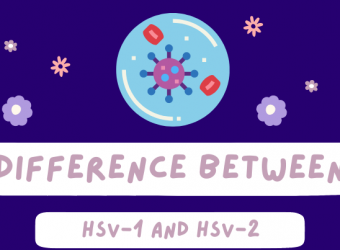What is the Difference Between HSV-1 and HSV-2
Herpes simplex virus (HSV) is a highly contagious virus that is transmitted through close personal contact, typically through sexual contact or skin-to-skin contact. There are two types of herpes simplex virus: HSV-1 and HSV-2. Although both types of herpes simplex virus can cause similar symptoms, there are some differences between the two.
HSV-1
HSV-1 is typically associated with oral herpes, which causes cold sores or fever blisters on or around the mouth. However, it can also cause genital herpes if it is transmitted through oral sex. Most people with HSV-1 acquire the virus during childhood, usually through non-sexual contact, such as sharing utensils or kissing an infected person.
Symptoms of HSV-1 may include:
- Cold sores or fever blisters on or around the mouth
- Tingling, itching or burning on or around the mouth
- Swollen lymph nodes in the neck
- Painful blisters on or around the mouth
The virus can be transmitted through skin-to-skin contact, such as kissing or sharing utensils, as well as through contact with infected saliva. In some cases, HSV-1 can also be transmitted to the genitals through oral sex.
HSV-2
HSV-2 is typically associated with genital herpes, which causes painful sores or blisters on or around the genitals. Most people with HSV-2 acquire the virus through sexual contact with an infected partner. However, it is possible to contract HSV-2 through non-sexual contact as well.
Symptoms of HSV-2 may include:
- Painful blisters or sores on or around the genitals
- Itching or burning in the genital area
- Swollen lymph nodes in the groin
- Flu-like symptoms, such as fever and headache
The virus is transmitted through sexual contact, including vaginal, anal, and oral sex. It is most contagious during outbreaks, when symptoms are present, but it can also be spread even when there are no visible symptoms.
Treatment and Prevention
There is no cure for either type of herpes simplex virus, but antiviral medications can help to reduce the severity and frequency of outbreaks. These medications can also help to reduce the risk of transmitting the virus to others.
Prevention is key when it comes to avoiding herpes simplex virus. To reduce the risk of contracting HSV-1, avoid sharing utensils or engaging in close contact with people who have cold sores or fever blisters. To reduce the risk of contracting HSV-2, practice safe sex by using condoms during sexual activity.
Both HSV-1 and HSV-2 can cause similar symptoms, but they are typically associated with different types of herpes. HSV-1 is typically associated with oral herpes, while HSV-2 is typically associated with genital herpes. While there is no cure for either type of herpes simplex virus, there are treatments available that can help to reduce the severity and frequency of outbreaks. Additionally, practicing safe sex and avoiding close contact with people who have active herpes outbreaks can help to reduce the risk of contracting the virus.
